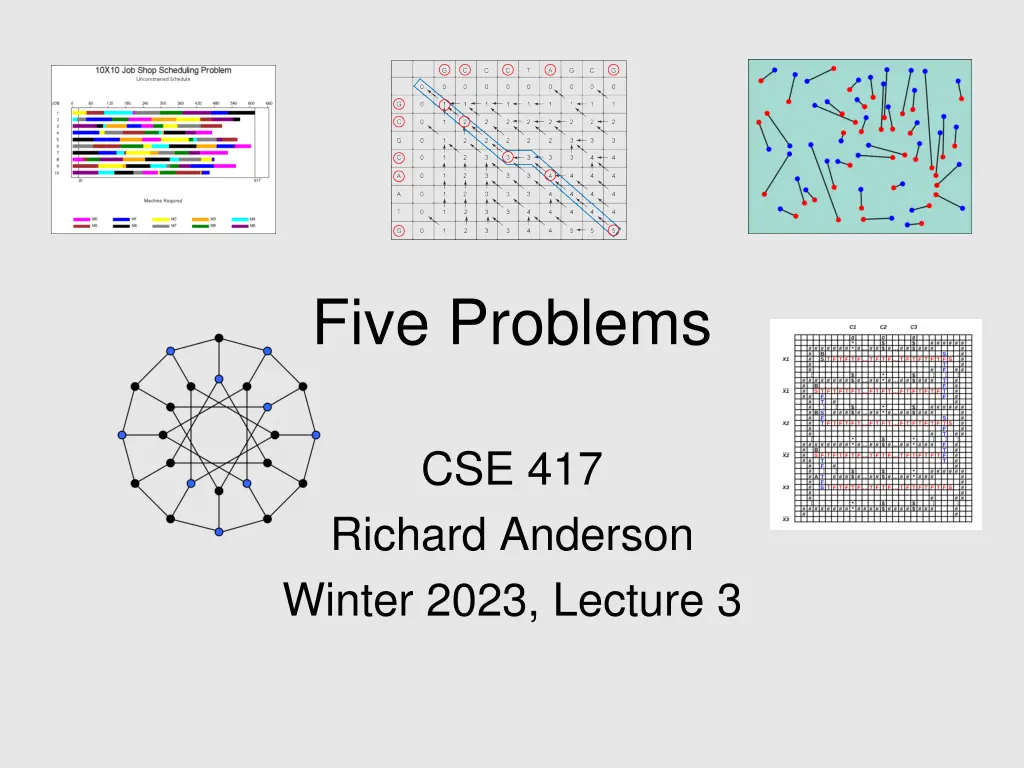
Exploring Expertise and Problem Solving in CSE 417 Winter 2023
Dive into the world of problem-solving with the CSE 417 course in Winter 2023, led by Richard Anderson. Discover the types of problems tackled in class, from scheduling to competitive facility location. Learn about expertise and the differences between experts and novices. Uncover the greedy algorithm and how it aids in finding solutions. Join the journey in understanding the theory of algorithms through practical examples and applications.
Download Presentation

Please find below an Image/Link to download the presentation.
The content on the website is provided AS IS for your information and personal use only. It may not be sold, licensed, or shared on other websites without obtaining consent from the author. If you encounter any issues during the download, it is possible that the publisher has removed the file from their server.
You are allowed to download the files provided on this website for personal or commercial use, subject to the condition that they are used lawfully. All files are the property of their respective owners.
The content on the website is provided AS IS for your information and personal use only. It may not be sold, licensed, or shared on other websites without obtaining consent from the author.
E N D
Presentation Transcript
Five Problems CSE 417 Richard Anderson Winter 2023, Lecture 3
Announcements Course website: //courses.cs.washington.edu/courses/cse417/23wi/ Homework Due Friday Office Hours: Richard Anderson, Tuesday, 2:30-3:30 PM, Thursday, 4:00-5:00 PM Nickolay Perezhogin, Thursday, 10:00 AM - 12:00 PM Artin Tajdini, Wednesday, 2:30 PM - 4:30 PM Tom Zhaoyang Tian,Wednesday, 12:30 PM - 1:30 PM Friday, 4:30 PM - 5:30 PM Michael Wen, Monday, 11:30 AM - 12:30 PM Thursday, 1:30 PM - 2:30 PM Albert Weng, Tuesday, 10:30 AM - 11:30 AM Friday, 9:30 AM -10:30 AM Yilin Zhang, Monday, 3:30 PM - 5:30 PM
Theory of Algorithms What is expertise? How do experts differ from novices?
Introduction of five problems Show the types of problems we will be considering in the class Examples of important types of problems Similar looking problems with very different characteristics Problems Scheduling Weighted Scheduling Bipartite Matching Maximum Independent Set Competitive Facility Location
What is a problem? Instance Solution Constraints on solution Measure of value
Problem: Scheduling Suppose that you own a banquet hall You have a series of requests for use of the hall: (s1, f1), (s2, f2), . . . Find a set of requests as large as possible with no overlap
Greedy Algorithm Test elements one at a time if they can be members of the solution If an element is not ruled out by earlier choices, add it to the solution Many possible choices for ordering (length, start time, end time) For this problem, considering the jobs by increasing end time works
Suppose we add values? (si, fi, vi), start time, finish time, payment Maximize value of elements in the solution 2 1 5 1 2 4 1 3 6 1
Greedy Algorithms Earliest finish time Maximum value Give counter examples to show these algorithms don t find the maximum value solution
Dynamic Programming Requests R1, R2, R3, . . . Assume requests are in increasing order of finish time (f1 < f2 < f3 . . .) Opti is the maximum value solution of {R1, R2, . . ., Ri} containing Ri Opti = Max{ j | fj < si }[Optj + vi]
Matching (Combinatorial Optimization) Given a bipartite graph G=(U,V,E), find a subset of the edges M of maximum size with no common endpoints. Application: U: Professors V: Courses (u,v) in E if Prof. u can teach course v
Reduction to network flow More general problem Send flow from source to sink Flow subject to capacities at edges Flow conserved at vertices Can solve matching as a flow problem
Maximum Independent Set Given an undirected graph G=(V,E), find a set I of vertices such that there are no edges between vertices of I Find a set I as large as possible
Find a Maximum Independent Set A C D B E G F H K J O S L I N T R M U Q P
Verification: Prove the graph has an independent set of size 8
Key characteristic Hard to find a solution Easy to verify a solution once you have one Other problems like this Hamiltonian circuit Clique Subset sum Graph coloring
NP-Completeness Theory of Hard Problems A large number of problems are known to be equivalent Very elegant theory
Are there even harder problems? Simple game: Players alternate selecting nodes in a graph Score points associated with node Remove nodes neighbors When neither can move, player with most points wins 2 6 4 3 5 2 6 3 1 4
6 4 6 5 5 4 5 6 1 6 2 1 4 2 5 8 7 8 5 4 4 5 4 4 3
Competitive Facility Location Choose location for a facility Value associated with placement Restriction on placing facilities too close together Competitive Different companies place facilities E.g., KFC and McDonald s
Complexity theory These problems are P-Space complete instead of NP-Complete Appear to be much harder No obvious certificate G has a Maximum Independent Set of size 10 Player 1 wins by at least 10 points
Summary Scheduling Weighted Scheduling Bipartite Matching Maximum Independent Set Competitive Scheduling
